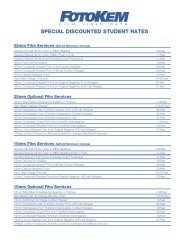Student Services Guide - FotoKem
Student Services Guide - FotoKem
Student Services Guide - FotoKem
Create successful ePaper yourself
Turn your PDF publications into a flip-book with our unique Google optimized e-Paper software.
made with built-in corrections.<br />
• Answer prints (the fi nal approved print after color timing) are typically made from the cut original camera negative using the lab color<br />
timer’s instruction. They may also be printed from a composite negative, created with a laser scanner from conformed fi nished<br />
digital acquisition fi les. If the negative is created by a laser recorder, all optical and color correction information applied to the digital<br />
master will be recorded to the conformed archival negative.<br />
DIGITAL MASTERING<br />
• Traditionally, the inter-positive or inter-negative fi lm element is used in telecine for the creation of the digital master. In the process of<br />
telecine mastering it is important to realize that extensive scene-to-scene color correction will be required. This is because the fi lm’s<br />
fi nal color timing, as applied to the creation of the intermediate fi lm element for printing, will not directly correlate to video color space.<br />
• If originated on HD videotape, tape-to-tape color grading will usually occur after online assembly. If origination was fi le-based, HD,<br />
2K or 4K data, an HD conversion video master may be used for tape-to-tape color grading.<br />
• For full resolution fi nishing of RAW acquisition fi les (higher than HD resolution), original RAW image fi les will require rendering to an<br />
uncompressed fi le format such as .dpx, Open EXR, or other uncompressed fi le format. These uncompressed fi les offer the highest<br />
possible picture quality to the Digital Intermediate (DI) process. This method of fi nishing is signifi cantly more expensive than fi nishing<br />
with rendered HD fi les, but it yields the highest possible quality archival master.<br />
• If you plan to accomplish color correction in an off-line editorial platform, <strong>FotoKem</strong> highly recommends that a ‘fi nal’ color grading<br />
pass, in a fully calibrated environment, with a professional colorist, be accomplished. Especially if the fi nished master is to be<br />
projected digitally in a theater, or broadcast to SMPTE specifi cations.<br />
NEW ACQUISITION TECHNOLOGIES<br />
• Although some new acquisition technologies allow for native ingest into editing systems, some pro-sumer devices such as Go Pro,<br />
5D, 7D, etc. may not be as easily introduced to the workfl ow as many pro-sumer cameras do not generate time code. Therefore<br />
it is important to identify, in pre-production, the appropriate dailies workfl ow, sound sync procedures, and QC requirement. Other<br />
considerations include archiving, data management, data integrity, codecs, color-space, offl ine vs. conform resolutions, and many<br />
other technical considerations that extend beyond the scope of off-line editorial. Consequently it is still essential, especially for<br />
multi-camera long-form projects, to partner with a professional post production facility to ensure all the bases are adequately<br />
covered. http://www.fotokem.com/resources/cameratypes.php<br />
CONTACT<br />
• Main Number: 818-846-3101<br />
• <strong>Student</strong> <strong>Services</strong>: ext. 558<br />
• Sales: ext. 520<br />
• nextLAB: ext. 406<br />
• Telecine Scheduling: ext. 366, ext. 412<br />
• Production <strong>Services</strong>: ext. 825<br />
• Questions: education@fotokem.com<br />
• Website: fotokem.com<br />
• Address: 2801 W. Alameda Avenue Burbank, CA 91505<br />
www.fotokem.com<br />
© 2012 <strong>FotoKem</strong> Industries, Inc.



